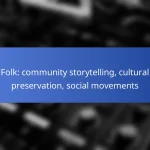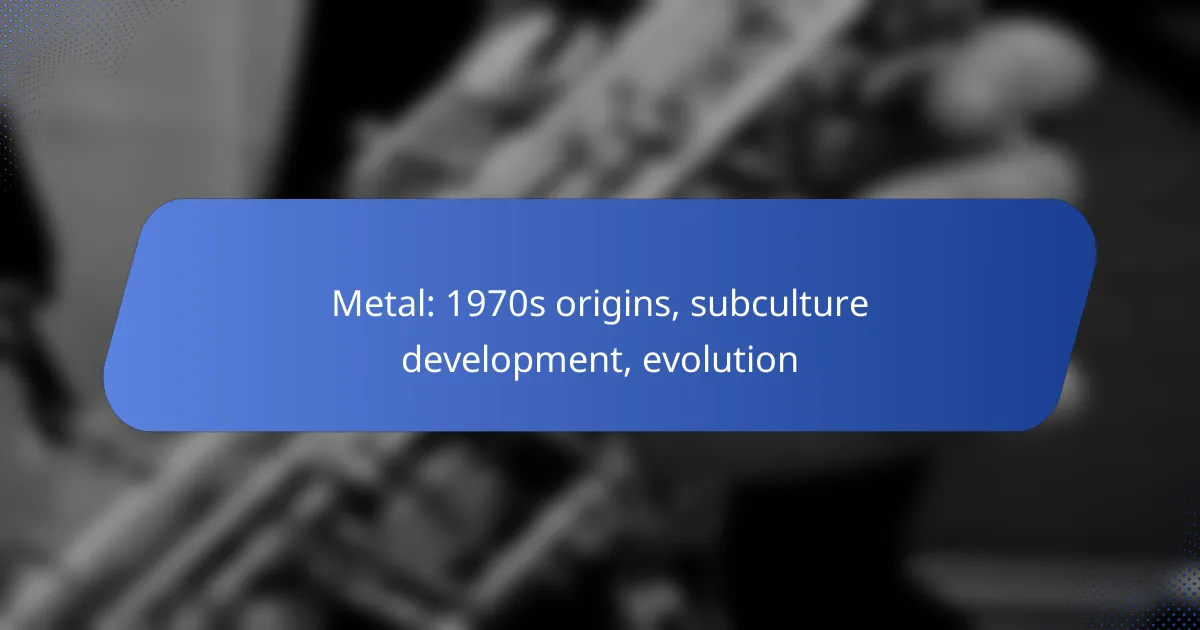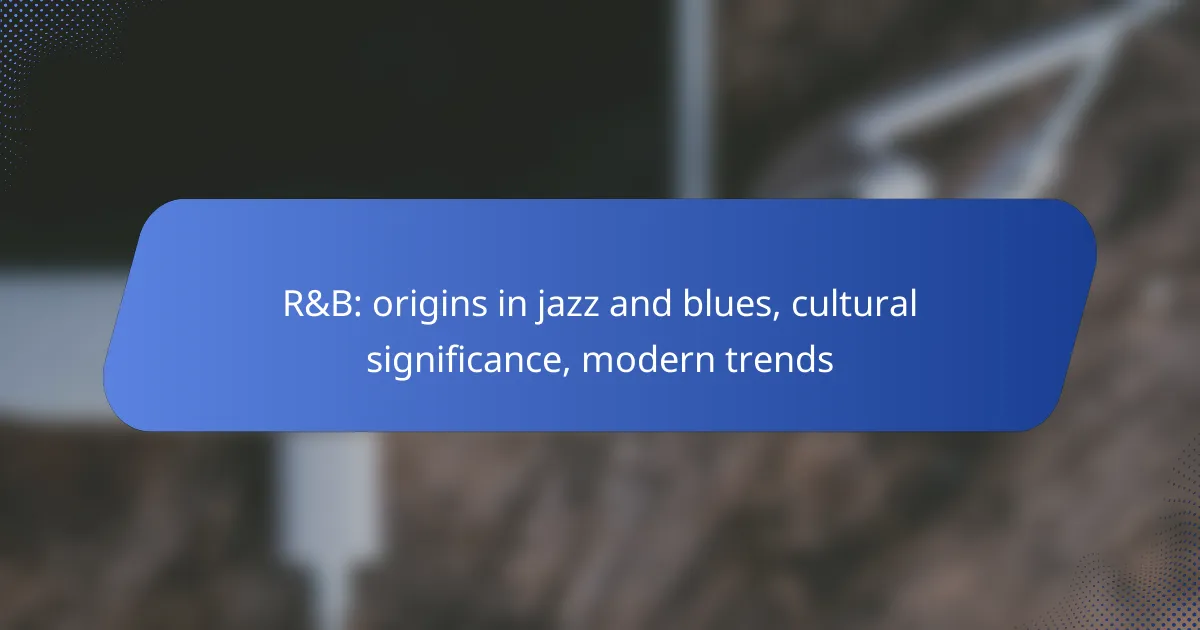Rock music originated in the 1950s as a fusion of rhythm and blues, country, and gospel, quickly gaining popularity and reshaping youth culture. This genre not only influenced the music industry but also sparked a cultural revolution, encouraging young people to express their individuality and challenge societal norms. Over the decades, rock has evolved significantly, adapting to cultural shifts and technological advancements while giving rise to diverse subgenres that reflect the changing tastes of its audience.

How did rock music originate in the 1950s?
Rock music originated in the 1950s as a fusion of various musical styles, primarily rhythm and blues, country, and gospel. This genre quickly gained popularity, influencing youth culture and shaping the music industry in profound ways.
Influence of rhythm and blues
Rhythm and blues (R&B) played a crucial role in the development of rock music. Artists like Ray Charles and Ruth Brown brought a strong backbeat and expressive vocals that became foundational elements in rock. The electric guitar, prominent in R&B, also became a staple in rock music, driving its energetic sound.
The transition from R&B to rock involved a shift towards more upbeat tempos and a focus on youth themes, which resonated with the emerging teenage demographic of the time. This genre’s influence can still be felt in modern rock music, showcasing its lasting impact.
Impact of country music
Country music significantly influenced the sound and style of early rock music. The incorporation of elements such as twangy guitars and storytelling lyrics helped shape the genre’s identity. Artists like Hank Williams and Johnny Cash introduced a narrative style that appealed to a wide audience.
The blending of country with rhythm and blues created a unique sound that defined rockabilly, a subgenre of rock music. This fusion attracted fans from both genres, expanding rock’s reach and popularity during the 1950s.
Key artists: Chuck Berry, Elvis Presley
Chuck Berry is often hailed as one of the pioneers of rock music, known for his innovative guitar riffs and energetic performances. His songs, such as “Johnny B. Goode,” showcased the storytelling aspect of rock and influenced countless musicians who followed.
Elvis Presley, dubbed the “King of Rock and Roll,” brought a charismatic stage presence and a blend of musical styles that captivated audiences. His hits, including “Heartbreak Hotel” and “Hound Dog,” helped propel rock music into mainstream culture, making it a defining sound of the 1950s.

What cultural revolution did rock music inspire in Australia?
Rock music inspired a significant cultural revolution in Australia during the 1950s and 1960s, marking a shift towards youth empowerment and social change. This movement encouraged young Australians to express their individuality, challenge societal norms, and embrace new forms of music and lifestyle.
Youth culture and rebellion
The emergence of rock music in Australia coincided with a growing youth culture that sought to break away from traditional values. Young people embraced rock as a form of rebellion against the conservative norms of their parents’ generation, often expressing their discontent through fashion, language, and music. This cultural shift was characterized by a desire for freedom and self-expression.
Rock music became a soundtrack for protests and movements advocating for social change, including issues like civil rights and anti-war sentiments. The genre’s raw energy and themes of defiance resonated with the youth, fostering a sense of community among those who felt marginalized by mainstream society.
Rise of Australian rock bands
The 1960s saw the rise of iconic Australian rock bands that shaped the local music scene and contributed to the global rock phenomenon. Bands like The Easybeats and The Seekers gained popularity, blending international rock influences with Australian culture. Their success paved the way for future generations of musicians.
As Australian rock bands gained traction, they began to develop a distinct sound that reflected local experiences and issues. The emergence of festivals and live music venues provided platforms for these bands to showcase their talent, further solidifying rock music’s place in Australian culture. This period laid the groundwork for the diverse rock genres that would follow, influencing countless artists and shaping the music landscape in Australia.

How has rock music evolved over the decades?
Rock music has transformed significantly since its inception in the 1950s, adapting to cultural shifts and technological advancements. Each decade has introduced new subgenres and styles, reflecting the changing tastes and social contexts of its audience.
Transition to hard rock and punk
The late 1960s and 1970s saw the emergence of hard rock, characterized by heavier guitar riffs and powerful vocals. Bands like Led Zeppelin and Deep Purple pushed the boundaries of rock, leading to a more aggressive sound.
Punk rock emerged in the mid-1970s as a reaction against the perceived excesses of hard rock and mainstream music. With bands like The Ramones and Sex Pistols, punk emphasized simplicity, speed, and a DIY ethos, influencing countless artists and subcultures.
Influence of grunge and alternative rock
The 1990s introduced grunge and alternative rock, which blended elements of punk, metal, and indie music. Bands like Nirvana and Pearl Jam brought a raw, emotional sound that resonated with a generation, often addressing themes of disillusionment and social issues.
This era marked a shift in rock music’s cultural relevance, as alternative rock gained mainstream popularity and challenged the conventions of earlier rock styles. The genre’s influence continues to be felt today, inspiring new artists and evolving into various subgenres.

What are the defining characteristics of rock music genres?
Rock music genres are characterized by their distinct instrumentation, sound, and lyrical themes. These elements combine to create a wide range of styles, each with its own unique identity and cultural significance.
Instrumentation and sound
Rock music typically features electric guitars, bass guitars, drums, and often keyboards. The sound can vary significantly between subgenres, from the heavy distortion of hard rock to the melodic tones of pop rock.
Instrumentation plays a crucial role in defining a genre. For instance, punk rock emphasizes raw energy and simplicity, while progressive rock incorporates complex arrangements and varied instrumentation, including orchestral elements.
Lyrical themes and storytelling
Lyrical themes in rock music often explore personal experiences, social issues, and rebellion. Common topics include love, heartbreak, political commentary, and existential questions, reflecting the cultural context of the times.
Storytelling in rock can be direct or abstract, with artists using vivid imagery and metaphor to convey emotions. For example, classic rock often tells stories of youth and freedom, while alternative rock may delve into introspective and sometimes darker themes.

How did rock music influence other genres?
Rock music has significantly influenced various genres by introducing new rhythms, instrumentation, and cultural themes. Its fusion with other styles has led to the evolution of pop, hip-hop, and electronic music, creating diverse sounds that resonate with different audiences.
Fusion with pop and hip-hop
The fusion of rock with pop and hip-hop has created a dynamic sound that appeals to a broad audience. Artists like Linkin Park and Kid Rock have successfully blended rock elements with hip-hop beats and catchy pop hooks, resulting in chart-topping hits.
This crossover has allowed for innovative collaborations, where rock musicians often feature hip-hop artists, enhancing their reach and influence. The rhythmic complexity of hip-hop complements rock’s melodic structures, creating a fresh listening experience.
Impact on electronic music
Rock music has also left a mark on electronic music, particularly through the incorporation of rock instruments and vocal styles. Bands like The Prodigy and Daft Punk have integrated guitar riffs and live drums into their electronic compositions, bridging the gap between genres.
The use of sampling in electronic music often draws from classic rock tracks, allowing for a nostalgic yet modern sound. This blending has led to the emergence of subgenres, such as electronic rock, which continues to evolve as artists experiment with new technologies and sounds.

What role did technology play in rock music’s evolution?
Technology has significantly influenced the evolution of rock music by enhancing sound quality, expanding distribution channels, and introducing new forms of media. Innovations in recording and production techniques have allowed artists to experiment with their sound, while the rise of music videos has transformed how fans engage with music.
Advancements in recording techniques
Recording techniques have evolved from basic analog methods to sophisticated digital processes, allowing for greater clarity and creativity. Multi-track recording, for instance, enables artists to layer different instruments and vocals, creating a richer sound. This technology has led to iconic albums that showcase complex arrangements and innovative soundscapes.
Moreover, advancements like digital audio workstations (DAWs) have democratized music production, enabling aspiring musicians to produce high-quality recordings from home. This shift has resulted in a diverse range of rock subgenres, as independent artists can now experiment without the constraints of traditional studio settings.
Emergence of music videos
The emergence of music videos in the 1980s revolutionized the way rock music was consumed and marketed. Platforms like MTV popularized the visual representation of music, allowing artists to create a distinct image and narrative that complemented their songs. This visual medium became essential for promoting singles and albums, often influencing their commercial success.
Music videos also fostered a deeper connection between artists and fans, as viewers could experience the music in a more immersive way. Today, platforms like YouTube continue to play a crucial role in the music industry, providing artists with a global stage to showcase their work and engage with audiences directly.

What are the current trends in rock music?
Current trends in rock music include a resurgence of classic rock sounds and the integration of digital platforms for music distribution and promotion. These trends reflect both a nostalgia for traditional rock elements and the adaptation to modern technology in the music industry.
Revival of classic rock sounds
The revival of classic rock sounds is characterized by contemporary artists drawing inspiration from the music of the 1960s and 1970s. Bands and solo musicians are incorporating vintage guitar riffs, analog recording techniques, and lyrical themes reminiscent of that era.
This trend is evident in the works of various artists who blend old-school rock with modern influences, creating a sound that appeals to both older and younger audiences. For example, groups like Greta Van Fleet and The Struts have gained popularity by channeling the spirit of classic rock while adding their unique twist.
Integration of digital platforms
Digital platforms have transformed how rock music is produced, distributed, and consumed. Streaming services like Spotify and Apple Music allow artists to reach global audiences quickly, while social media platforms provide tools for direct engagement with fans.
Artists are leveraging these platforms not only for music distribution but also for marketing and brand building. For instance, many rock bands use platforms like TikTok to share snippets of their music, engage with fans, and create viral trends that can significantly boost their visibility.










